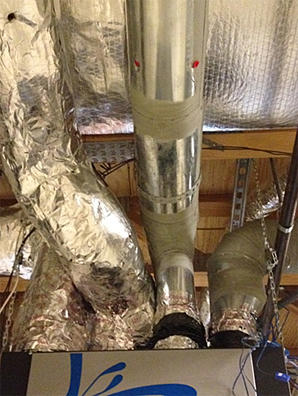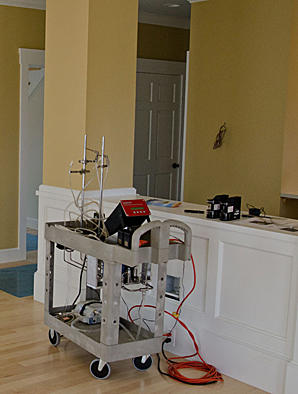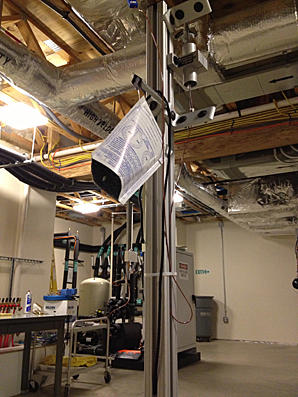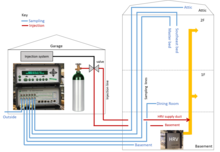Indoor Air Quality and Volatile Organic Compounds
|
Heat Recovery Ventilator (HRV) Airflow Rates The airflow rates of the heat recovery unit used to provide outdoor air to the house are being measured to confirm it performs per the house design specifications. This unit brings outdoor air into the house and exhausts indoor air, with heat exchange between the two airstreams to reduce the energy needed to condition the outdoor air. The unit was sized to comply with the outdoor air requirements in ASHRAE Standard 62.2 Ventilation and Acceptable Indoor Air Quality in Low-Rise Residential Buildings, which for this building is about 38 L/s (80 cfm). The outdoor airflow rate provided by the HRV has been measured on several occasions and the results are consistent with this design value. |

HRV unit and associated ductwork |
|
VOC and formaldehyde The building materials for the net-zero house were specified to have low emissions of volatile organic compounds (VOC), including a prohibition on products with any added formaldehyde. Indoor air samples have been collected and analyzed to determine the levels of about two dozen individual VOCs and formaldehyde in order to determine the impact of the building material specifications. These samples are being collected approximately monthly and will be used to determine VOC emission rates for the house and to determine if there are any changes over time. Additional samples need to be taken before the reliability of the measurements can be determined, but the concentrations appear to be quite low, particularly for formaldehyde. |

VOC and formaldehyde sampling apparatus |
|
Radon The NZERTF contains a passive radon mitigation system. Measurements were conducted in the building to evaluate the indoor radon levels, in part to assess the effectiveness of that system. Charcoal test kits were deployed following the EPA Protocols For Radon and Radon Decay Product Measurements in Homes. Measurements were made in the basement, first floor, and second floor during seven different three-day periods from February 2013 to June 2018. All of the living space samples were below the EPA action level of 4 pCi/L. Two samples above that level, specifically 5 pCi/L, were taken in the basement during rainstorms, which can increase the rate at which radon can enter a ground-contact floor. |

Radon charcoal test kit in basement |
|
Tracer Gas System In October 2017, installation of a Photoacoustic Infrared Spectroscopy Multi Gas Measurement System was completed in order to continuously monitor the concentration of a tracer gas (i.e., a chemical that is non-reactant and not found in the outdoor air) injected at periodic intervals into the supply duct of the heat recovery ventilator (HRV). The tracer gas to be used is sulfur hexafluoride (SF6). Plans are underway to add the capability of measuring carbon dioxide (CO2) to the unit in order to monitor the CO2 generated by the virtual occupants in the future as a means of characterizing building ventilation and air distribution. The tracer system and SF6 injection gas cylinder are located in the garage. Sampling points in the house include the basement, dining room, office, living room, master bedroom, southeast bedroom, southwest bedroom, attic, and outdoors. The injection points in the house are the HRV and basement. |

Schematic of NIST NZERTF Tracer Gas System |

